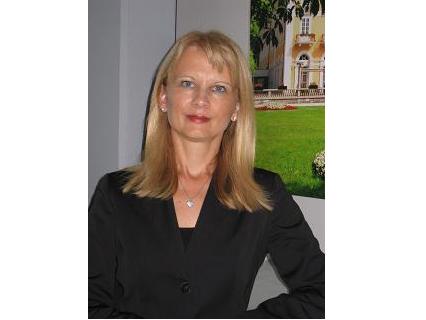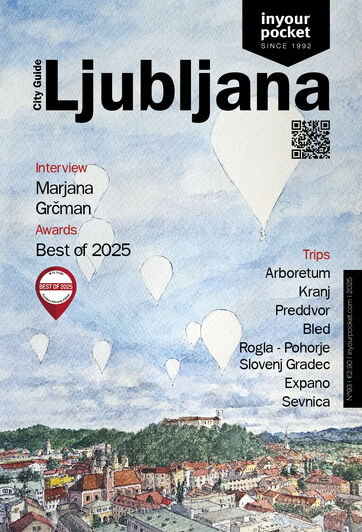We recently sat down with Maja Pak, the acting director of the Slovenian Tourist Board, to discuss the current state of tourism in Slovenia, including branding, green tourism and some of the country's undiscovered gems.

How long have you been at the STB? And why did you first decide to work in the tourism sector?
My decision to work in tourism came naturally. I grew up in one of the oldest and most important tourist areas in Slovenia - Rogaška Slatina. I started my career at the Rogaška Slatina health resort where I gained a lot of priceless experience in tourism. Later I continued my career at the STB. This year is already my fifteenth year at the STB, and since August in position of acting director.
What is the role of the Slovene Tourism Board?
The Slovenian Tourist Board (STB) is a major national tourist organization for planning and performing the promotion of our country as a tourist destination, linking the existing products and programs of national importance and advancing the progress of new ones, establishing integral tourist information infrastructure and executing research and development work. The STB is the contact and central point in the complex network of Slovenian tourism which plays a coordinating and linking role between the public, private and civil society. The STB would like to position Slovenia as a clearly and easily recognizable tourist country with precisely determined comparative and competitive advantages based on sustainable development which will definitely contribute to the marketing of the Slovenian tourist offer. The STB builds upon the relationship of partnership and has partners from private, public and civil areas of tourism. The relationship of partnership was transmitted to the marketing strategy and built into the whole process of planning, organizing and implementing promotional and marketing activities.
What are the biggest challenges facing the tourism industry in Slovenia?
One of the biggest challenges for the tourism industry in Slovenia in the near future is certainly the preparation of a new development and marketing strategy. The key focus of the strategy will be sustainable ('green') tourism, which is strongly linked to the climate change issue. At the STB we've done a lot of research to recognize the dimension of the issue and studied the impacts of tourism on the climate and the climate on tourism. As well we are putting a lot of attention on changes in tourist flows. Tourist flows are more and more affected not only by climate change but also by world competition which has brought attractive and low-cost destinations closer to the buyer; there are demographic changes going on leading to an aging population, and we are faced with rapid development of information and communication technologies. Another important challenge is to increase the competitiveness of Slovenian tourism. For easier access to Slovenia we have to improve air and railway infrastructure. It is important to promote direct foreign investment, improve factors of regulation and the business environment, create conditions to motivate human resources and develop more effective marketing. In the field of marketing we need to upgrade segmentation and find new target groups with higher income who are willing to spend more for their holidays in Slovenia. Therefore it is necessary to create attractive and innovative products with high added value, excellent service and proper positioning of Slovenia as a tourist destination.These are only few challenges that will need to be confronted if we want to attract more tourists to Slovenia, to improve our image and increase the share on the global market.
How has the ongoing worldwide financial crisis affected the Slovene tourism industry?
The global financial crisis, whose effects can still be felt in Slovenian, European and global tourist flows, was clearly reflected in statistical data of Slovenian tourism on tourist arrivals and overnight stays by foreign visitors at the end of 2009. According to provisional data from the Statistical Office of the Republic of Slovenia, Slovenian accommodation facilities registered 6 percent fewer foreign visitors and 7 percent fewer overnight stays by foreigners at the end of 2009 compared to 2008. At the same time, however, Slovenia registered a 6 percent increase in the number of domestic visitors and their overnight stays. The latter was consistent with global tourism forecasts, which predicted that people would be more likely to take their holidays in their home country. The data show that Slovenian tourism was affected by the financial crisis, as the statistical data were below expectations. At the STB we are well aware of this fact, so in order to curb the negative effects of the financial crisis we adopted several key measures on which market communication activities for the promotion of Slovenia and Slovenian tourism are based to ensure that the results achieved in 2010 will be better then at the ones in 2009. The first seven months of 2010 show a positive trend of tourist arrivals and overnight stays especially by foreign visitors, while domestic visitors and their overnight stays are on the same level as last year. However there was a decrease in domestic overnights in August.
What does Slovenia have to offer visitors that they can't find in neighbouring countries with more established tourism industries - namely Italy and Croatia?
Slovenia lies at the crossroads of the Alps and Mediterranean and that is the reason for the astonishing diversity that makes it so attractive.The main tourism products of Slovenia are all closely connected with nature. The country is the third-most forested in Europe, after Finland and Sweden, with a diverse and unspoilt landscape. It is this landscape that makes Slovenia a perfect destination for hiking, Nordic walking, cycling, golf, all kinds of water-based activities, winter sports and agricultural tourism, not to mention Slovenian gastronomy which is based on a wide variety of local and regional food. As well as these facts, Slovenia boasts:- Almost 60% of its land covered in forests
- Several preserved original forest reserves, including one located just 60 kilometres from the capital, Ljubljana
- A full 36% of its land lying inside Natura 2000 areas (a network of protected areas of European importance)
- Over 22,500 animal and plant species, placing it among the countries with the highest level of biological diversity in Europe
- Less than 0.004% of the Earth's surface but being home to more than 1% of all known living creatures and more than 2% of all land and freshwater species
- Drinking water that is among the purest in Europe and even the world
Being one of the most culturally and geographically diverse states in the world has obvious advantages in terms of attracting tourists, but does it also pose certain challenges - perhaps in terms of branding and inter-regional cooperation?
Branding is always a challenge, but I wouldn’t say that diversity would make things more difficult, but it also doesn’t make branding easier. When a tourist is travelling through Slovenia he is continually surprised by its changing landscape and diversity that can be discovered on only 20,000 km². It is true that in Slovenia we cannot expose only one icon that would represent our country around the world (like for example Adriatic coast represents Croatia). But diversity has one clear vision, which is implemented by the Slovenian brand I FEEL SLOVENIA. We feel Slovenia - all together, with all our senses. This is the key message which represents Slovenia abroad. And there is another thing which links cultural and geographical diversity. In Slovenia green is more than just a colour, it's 'Slovenian green'. From here on we are building our overall strategy of green tourism. At this point I would also like to mention a good example of regional co-branding with Croatia. Recently we organized joint promotion in the Indian market under the slogan 'Feel Slovenia. Experience Croatia', which was very well accepted among business partners.
In recent years 'Green' or 'Sustainable' Tourism have become buzz words in the tourism sector. What exactly do they mean?
Recently there has been increasing talk about tourism in a green economy, about green tourism, about adapting to and mitigating climate change in relation to tourism, about the green market, green programmes and so on. Originally the term 'GREEN' related in business operations to environmental matters, but now it embraces all aspects of sustainable development, based on four basic principles (UNWTO): environmental, social, economic and climate. Green tourism minimises the environmental impact of tourism and maximises its adaptation to climate change.
Where is Slovenia at in terms of Green and Sustainable development compared with other European and international destinations? And where will it be in 5-10 years?
We are convinced that sustainable or green tourism is a developmental opportunity for Slovenia.It is a response from all stakeholders in tourism to the changes in the environment, aimed at ensuring the long-term competitiveness of Slovenian tourism and increasing the quality of life of Slovenia’s inhabitants.The role of the STB is to present the economic, social and environmental benefits of sustainable development, and especially encourage the tourist industry towards the implementation of sustainable business models. Sustainable development of tourism in Slovenia is being put into practice step by step.
Here are some of the good examples:
- Terme Snovik - the first tourism company to acquire the EU Flower in Slovenia.www.terme-snovik.si
- Bohinj Park Hotel - the first eco-resort in Slovenia that meets the requirements of the prestigious Green Globe Certification Standard www.bohinj-park-hotel.si
- Eco Camp Canyon - the first ecological campsite in Slovenia that is built exclusively from natural materials. All energy is provided by the sun and water is used for cooling. www.adrenaline-check.com/eco_camp.php
- Winners and finalists selections EDEN (European Destination of Excellence) in Slovenia - destinations that have proved they are pursuing the principles of social, economic and environmental sustainability: EDEN 2009 The Soca valley www.dolina-soce.com, EDEN 2009 Solcavsko www.logarska-dolina.si and EDEN 2010 Kolpa Riverwww.kolpariver.eu. At the STB we are aware of the fact that the overall economy should follow examples of good practice and that many more steps towards green economy should be done.
What areas besides Green and Sustainable Tourism have the most potential for growth in Slovenia?
There is still a lot of potential for the tourism sector in Slovenia to grow and improve. First of all we have to be aware of the fact that Slovenia is not a mass tourism destination, which is why most potential for growth is in increasing the recognisability of Slovenia in target (niche) segments of demand. As mentioned above segmentation is one of the key challenges of Slovenian tourism in the near future. Another important thing to mention at this point is Slovenia’s geo-traffic position. We should take advantage of it for the design and marketing of cross-border tourism products which include the attractions of the wider region. In that way Slovenia can attract more overseas guest that visit Slovenia as one of the stops while traveling around Europe. To increase the recognisability of Slovene tourism we should exploit the potential of events, linking Slovene tourism with the organizers of various events (organizers of business, expert meetings, sports, cultural, religious events, programmes of 50 youth centres, etc.). Taking advantage of European Book Capital in 2012 is an excellent opportunity to increase the recognition of Slovenia as an attractive and regulated tourist country.
If you had friends from abroad visiting Slovenia for just one weekend, what would you recommend they see, do and eat?
I would recommend that they visit Ljubljana, the loveliest capital city in Europe, then one of three EDEN destinations mentioned above: The Soča Valley, Solčavsko, or the River Kolpa. All three destinations offer unique experience in the local environment and are still hidden treasures of Slovenia that have much to offer.
What's your favourite 'off the beaten path' place in Slovenia?
I keep on discovering them...






Comments